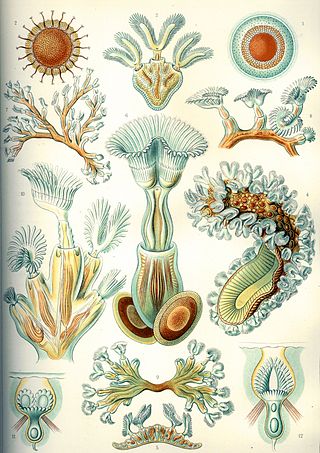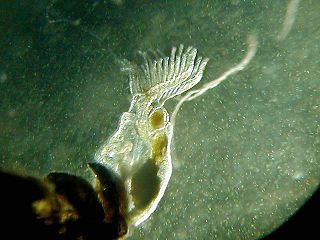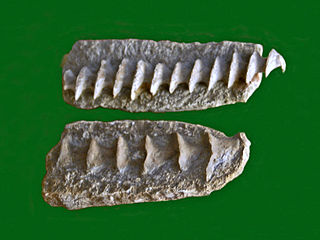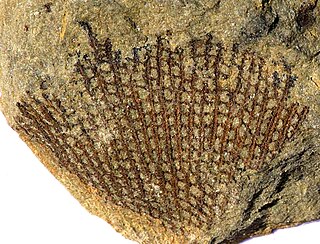
Bryozoa are a phylum of simple, aquatic invertebrate animals, nearly all living in sedentary colonies. Typically about 0.5 millimetres long, they have a special feeding structure called a lophophore, a "crown" of tentacles used for filter feeding. Most marine bryozoans live in tropical waters, but a few are found in oceanic trenches and polar waters. The bryozoans are classified as the marine bryozoans (Stenolaemata), freshwater bryozoans (Phylactolaemata), and mostly-marine bryozoans (Gymnolaemata), a few members of which prefer brackish water. 5,869 living species are known. At least two genera are solitary ; the rest are colonial.
Stenolaemata are a class of exclusively marine bryozoans. Stenolaemates originated and diversified in the Ordovician, and more than 600 species are still alive today. All extant (living) species are in the order Cyclostomatida, the third-largest order of living bryozoans.

Cheilostomatida, also called Cheilostomata, is an order of Bryozoa in the class Gymnolaemata.

Cyclostomatida, or cyclostomata, are an ancient order of stenolaemate bryozoans which first appeared in the Lower Ordovician. It consists of 7+ suborders, 59+ families, 373+ genera, and 666+ species. The cyclostome bryozoans were dominant in the Mesozoic; since that era, they have decreased. Currently, cyclostomes seldom constitute more than 20% of the species recorded in regional bryozoan faunas.

Phylactolaemata is a class of the phylum Bryozoa whose members live only in freshwater environments. Like all bryozoans, they filter feed by means of an extensible "crown" of ciliated tentacles called a lophophore, and like nearly all bryozoans, they live in colonies, each of which consists of clones of the founding member. Unlike those of some marine bryozoans, phylactolaemate colonies consist of only one type of zooid, the feeding forms known as autozooids. These are supported by an unmineralized "exoskeleton" made of gelatinous material or protein, secreted by the zooids. The class contains only one extant order, Plumatellida.

Archimedes is a genus of bryozoans belonging to the family Fenestellidae. The first use of the term "Archimedes" in relation to this genus was in 1838.

Trepostomatida is an extinct order of bryozoans in the class Stenolaemata. Trepostome bryozoans possessed mineralized calcitic skeletons and are frequently fossilized; some of the largest known fossilized bryozoan colonies are branching trepostomes and massive dome-shaped trepostomes. Trepostomes did not have many specialized zooecia beyond ordinary feeding autozooecia. The two main known heteromorphs are exilazooecia and mesozooecia, which had the purpose of maintaining regular spacing between autozooecia.
Ceramopora is an extinct genus of bryozoan of the family Ceramoporidae. It is one of the earliest genera of bryozoans. Its colonies were thin and discoid, with large autozooecia, abundant communication pores, lunaria, and monticules with depressions in their centers. It had no acanthostyles or diaphragms, distinguishing it from Acanthoceramoporella.

Fenestella is a genus of bryozoans or moss animals, forming fan–shaped colonies with a netted appearance. It is known from the Middle Ordovician to the early Upper Triassic (Carnian), reaching its largest diversity during the Carboniferous. Many hundreds of species have been described from marine sediments all over the world.
Paleontology or palaeontology is the study of prehistoric life forms on Earth through the examination of plant and animal fossils. This includes the study of body fossils, tracks (ichnites), burrows, cast-off parts, fossilised feces (coprolites), palynomorphs and chemical residues. Because humans have encountered fossils for millennia, paleontology has a long history both before and after becoming formalized as a science. This article records significant discoveries and events related to paleontology that occurred or were published in the year 2015.
Septopora is an extinct genus of bryozoan belonging to the order Fenestrida. It has been found in Pennsylvanian to Permian beds in North America, South America, Australia, and southwest and east Asia.
Dekayia is an extinct genus of Ordovician bryozoans of the family Heterotrypidae. Its colonies can be branching, encrusting, or massive. All species have acanthopores in varying sizes and numbers. The autozooecia appear angular or sub-angular viewed through a cross-section of the colony, and their walls are distinctively undulating or crenulated. Maculae generally protrude from the colony surface very little or at all, and can contain unusually large autozooecia and a cluster of mesozooecia in their centers.
Homotrypa is an extinct genus of bryozoans from the Ordovician and Silurian periods, known from fossils found in the United States. Its colonies are branch-like and have small monticules made of groups of three or four larger zooecia slightly protruding out from the main surface of the colony. In cross section, the zooecia are erect in axis and gently curve toward the surface of the colony.
Eridotrypa is an extinct genus of bryozoans of the family Aisenvergiidae, consistently forming colonies made of thin branches. Diaphragms are very common in colonies. Distinctively, in the exozone there are serrated dark borders separating the autozooecia.
Hemitrypa is an extinct genus of bryozoans that lived from the Devonian to the Permian period, belonging to the family Fenestellidae. Like some other fenestrate bryozoans, it produced a skeletal superstructure to protect the colony.
Mirifenestella is an extinct genus of bryozoans from the Devonian period, belonging to the order Fenestrata. Like some other fenestrate bryozoans, it produced a skeletal superstructure that protected the colony. It also developed specialized zooids known as "aviculomorphs" which occurred in pairs and may have been either for cleaning or defense purposes.
Fenestrapora is an extinct genus of bryozoans of the family Semicosciniidae that lived during the Devonian period. Its colonies have a net-like structure, shaped into a flaring funnel. It is distinct from most other fenestrate bryozoans due to its aviculomorphs, structures that are thought to have had the function of cleaning or defense.
Quadrisemicoscinium is an extinct genus of fenestrate bryozoan, known from the Early Devonian period, of the family Semicosciniidae. It formed net-like colonies of relatively thick branches with two rows of autozooids per branch, supported by a vesicular skeleton.
Dybowskites is an extinct genus of bryozoan of the family Ralfimartitidae, found in the Ordovician and Silurian periods. It forms branching, frond-like, or sometimes segmented colonies. In cross-sections of the colonies, the tubular autozooecia are seen growing alongside the branch axis and then bending abruptly to reach the colony surface at a perpendicular angle. There are many mesozooecia and large acanthostyles that protrude from the colony surface.
Palaeostomata is a superorder of extinct stenolaemate bryozoans, including all extinct orders within Stenolaemata and excluding the order Cyclostomata, which is the only extant stenolaemate order. Palaeostomates are sometimes called "stony bryozoans" because they are heavily calcified, making them ideal candidates for fossilization. They are distinct from cyclostomes because they lack calcified exterior walls above the basal lamina and because their zooecial tubes are transected by calcitic partitions, such as diaphragms.






